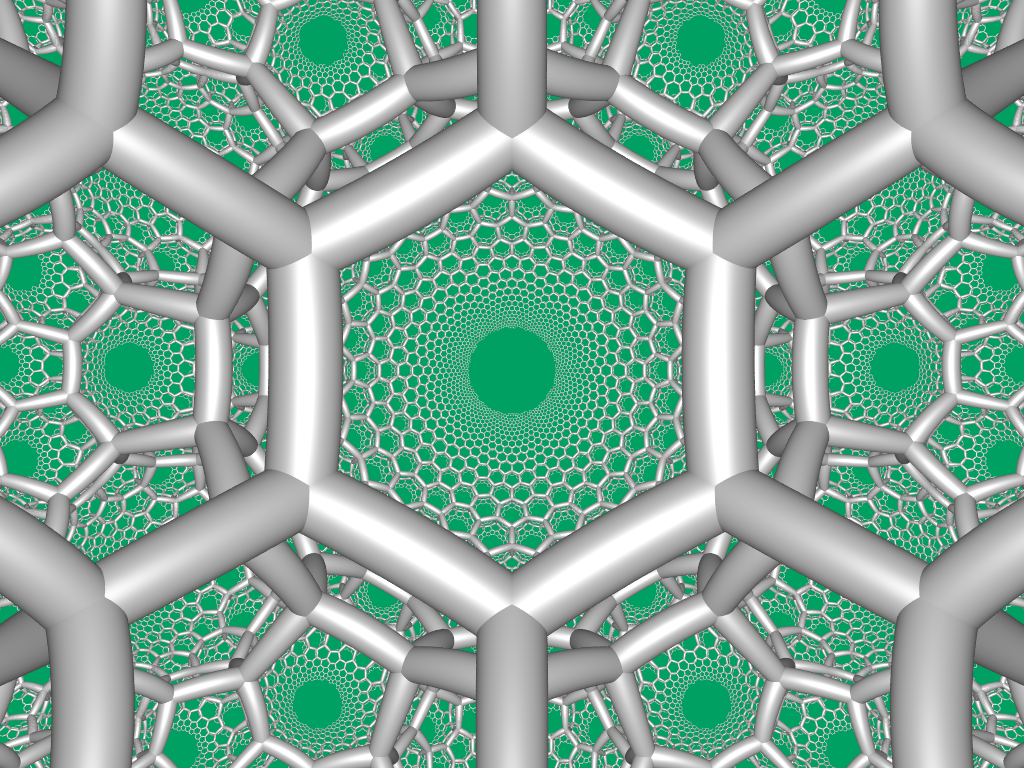This is the {6,3,3} honeycomb, drawn by Roice Nelson.
A 3-dimensional honeycomb is a way of filling 3d space with polyhedra. It’s the 3-dimensional analogue of a tiling of the plane. Besides honeycombs in 3d Euclidean space, we can also have honeycombs in 3d hyperbolic space, a non-Euclidean geometry with constant negative curvature. The {6,3,3} honeycomb lives in hyperbolic space. For another view of it, also by Roice Nelson, see:
• {6,3,3} honeycomb in upper half space, Visual Insight.
When I said a honeycomb is a way of filling 3d space with polyhedra, I was lying slightly. The {6,3,3} honeycomb is also called the hexagonal tiling honeycomb. The reason is that it contains many sheets of hexagons, tiling planes in the usual way hexagons do. These are flat Euclidean planes lying in 3d hyperbolic space, called horospheres. The sheets of hexagons are not exactly polyhedra, because they have infinitely many polygonal faces! So, the {6,3,3} honeycomb is an example of a ‘paracompact’ honeycomb.
The notation {6,3,3} is an example of a Schläfli symbol. The Schläfli symbol is defined in a recursive way. The symbol for the hexagon is {6}. The symbol for the hexagonal tiling of the plane is {6,3} because 3 hexagons meet at each vertex. Finally, the hexagonal tiling honeycomb has symbol {6,3,3} because 3 hexagonal tilings meet at each edge.
Just as the {6,3} inside {6,3,3} describes the hexagonal tilings inside the {6,3,3} honeycomb, the {3,3} describes the vertex figure of this honeycomb: that is, the way the edges meet at each vertex. {3,3} is the Schläfli symbol for the regular tetrahedron, and if you look at the picture you can can see that each vertex has 4 edges coming out, just like the edges going from the center of a tetrahedron to its corners.
The hexagonal tiling honeycomb is an example of a uniform honeycomb in 3d hyperbolic space. It is called regular because it is especially symmetrical: its symmetry group acts transitively on the set of flags, where a flag is a vertex lying on an edge lying on a face lying on cell (in this case, a sheet of hexagons).
As already mentioned, the hexagonal tiling honeycomb is called paracompact because it has infinite cells, which in this case are the hexagonal tilings {6,3}. There are 15 regular honeycombs in 3d hyperbolic space, of which 11 are paracompact. For more, see:
• Paracompact uniform honeycomb, Wikipedia.
The Coxeter diagram of the {6,3,3} honeycomb is
The symmetry group of the {6,3,3} honeycomb is a discrete subgroup of the symmetry group of hyperbolic space. This discrete group has generators and relations summarized by the unmarked Coxeter diagram:
This diagram says there are four generators s1,…,s4 obeying relations encoded in the edges of the diagram:
(s1s2)6=1
(s2s3)3=1
(s3s4)3=1
together with relations
s2i=1
and
sisj=sjsi if |i–j|>1
Marking the Coxeter diagram in different ways lets us describe many honeycombs with the same symmetry group as the hexagonal tiling honeycomb—in fact, 24–1=15 of them, since there are 4 dots in the Coxeter diagram! You can see some of these uniform honeycombs here:
• Hexagonal tiling honeycomb, Wikipedia.
Puzzle: The symmetry group of 3d hyperbolic space, not counting reflections, is PSL(2,C). Can you explicitly describe the subgroup that preserves the hexagonal tiling honeycomb?
Roice Nelson, the creator of this image, is a software developer with a passion for exploring mathematics through visualization:
• Roice.
Martin Weissman answered the puzzle on G+:
Well, it’s PSL2(Z[e2πi/3]), of course! :)
Since he’s an expert on arithmetic Coxeter groups, this must be about right! Theorem 10.2 here:
• Norman W. Johnson and Asia Ivic Weiss, Quadratic Integers and Coxeter Groups, Canad. J. Math. Vol. 51 (1999), 1307–1336.
is a bit more precise. It gives a nice description of the even part of the Coxeter group discussed in this article, that is, the part generated by products of pairs of reflections. To get this group, we start with 2 × 2 matrices with entries in the Eisenstein integers: the integers with a cube root of -1 adjoined. We look at the matrices where the absolute value of the determinant is 1, and then we ‘projectivize’ it, modding out by its center. That does the job!
They call the even part of the Coxeter group [3,3,6]+, and they call the group it’s isomorphic to P¯SL2(E]), where E is their notation for the Eisenstein integers, also called Z[e2πi/3]. The funny little line over the is a notation of theirs: SL2 stands for 2 × 2 matrices with determinant 1, but ¯SL2 is their notation for 2 × 2 matrices whose determinant has absolute value 1.
Visual Insight is a place to share striking images that help explain advanced topics in mathematics. I’m always looking for truly beautiful images, so if you know about one, please drop a comment here and let me know!




